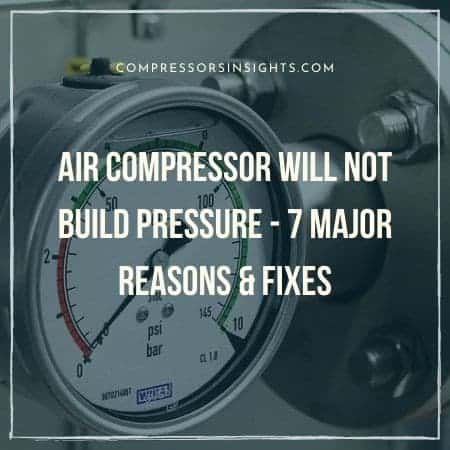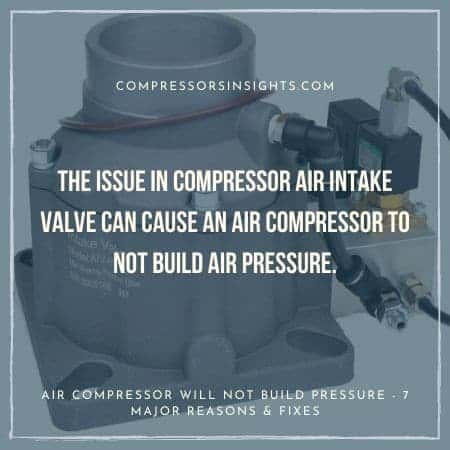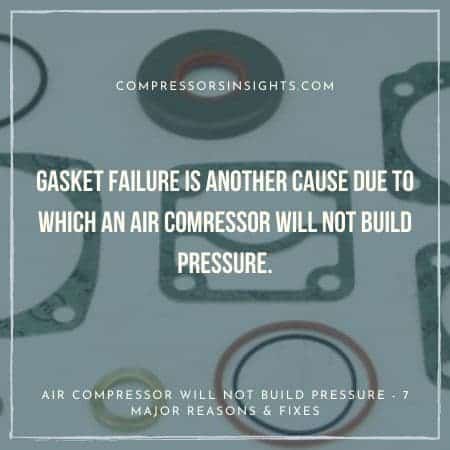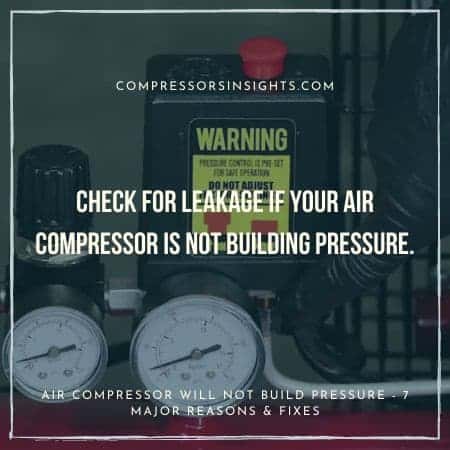Air Compressor Will Not Build Pressure – 10 Major Reasons & Fixes
TheToolGeeks.com is a participant in the Amazon Services LLC Associates Program and other affiliate advertising programs. We may earn from qualifying purchases. (Learn More).
Air compressors are used in projects where high air pressure is required, and when your air compressor stops building up pressure, that’s a problem. There are several factors due to which your air compressor will not build pressure.
This article discusses the reasons why an air compressor runs and won’t build air pressure, and what you can do about it. Also, how can you rebuild and reassemble the compressor after disabling it?
Trending: Air Compressor Won’t Start -Â 10 Major Reasons & Fixes!
Jump To Page Contents:

How Does an Air Compressor Work?
An air compressor is a machine used to compress and circulate air. It collects, compresses, and then distributes the collected air through pipes or hoses for use in pneumatic tools such as nail guns, staplers, spray paint equipment, etc.
After it has been compressed into a high-pressure hot gas (and sometimes cooled), it can be stored in a tank or an air receiver at normal temperature and pressure.
There are many types of compressors available with different working principles but each one works on the same principle which is compressing atmospheric gas into a smaller space making its volume lesser than before compression. They work by a mechanism called “gas power.”
Air Compressor Pressure Ranges (Big and Small Air Compressors)
The pressure ranges of big air compressors vary depending on how big the compressor is (industrial or standard big compressors).Â
The compressor’s pressure can range from 150-300 psi. If the compressor is even bigger (industrial), it can range from 200- 450 psi.Â
The small compressor can range from 70-90 psi. The pressure ranges of 60-100 also come in small or medium air compressors.Â
The single-stage compressor can be 100-130 psi. And two-stage compressor has 150-170/180 PSI.Â
How can I Check PSI on my Air Compressor?Â
If you want to check the psi of the compressor, then you need to read the compressor’s pressure gauge. A pressure gauge on the air compressor shows the available pressure in the compressor. Sometimes you may need to install the pressure gauge on the compressor, which might be installed on the unit or hose of the compressor.Â
Why Your Air Compressor Will not Build Pressure (Pressure at All or Enough Pressure) – Reasons & Fixes
There are a few reasons why an air compressor will not build pressure or build low pressure. One of the most common reasons is that something is blocking the airflow, such as dirt or debris. If the compressor can’t draw in air, it can’t create pressure.
Another common issue is a lack of lubrication. Without enough oil, the internal parts of the compressor will start to seize up.
A faulty pressure switch can also cause an air compressor not to build pressure, as it is designed to turn the machine on and off based on a pre-set threshold. If the part isn’t working properly, this cycle of turning on and off could prevent proper compression from happening at all.
1. Compressor Air Intake Valve Issue
If your compressor is not building pressure, you may have an intake valve issue. For the air or gas to enter the cylinder, it must pass through a set of valves that are designed to control both the compression and combustion rates to achieve the desired ratio.
This mixture cannot enter without passing through these valves first! The Intake valve is the first valve to open, and it allows for the mixture of gas and air to enter the cylinder. If this valve does not seal properly, then your compressor will not be able to build pressure.

Troubleshooting Compressor Intake Valve
To find out if your compressor has malfunctioned intake valve follow these steps:
- Remove the air intake filter
- Run your air compressor
- Check if the air is passing in or out of the intake valve. If yes, then the intake valve has an issue.
Note: Usually air compressor pumps become hot, so be careful while following these steps.
2. The issue in the Compressor Pressure Valve
If the engine has less than adequate compression, a valve or valves may be stuck open. That would affect performance and possibly prevent the pump from building pressure; however, this should not cause it to fail.
Typically you will find an intake valve sticking if there is no airflow into the compressor tank at all when trying to build pressure. If there is airflow, but no pressure builds after running the engine for a while (typically around five minutes), perhaps one of the exhaust valves may be stuck open.
An open pump pressure valve prevents the compressor from building pressure. When you close the pump pressure valve, see whether the compressor builds pressure. If it does, it is likely something else in the system that is causing the problem. If it still doesn’t build pressure, then there may be an issue with the compressor itself
3. Piston Ring Failure or Gasket Issue
When the air compressor does not build sufficient pressure, it could be due to a damaged piston seal or gasket. Determine if the piston is leaking oil and whether the gasket needs to be replaced. If you are unable to resolve the issue, contact a professional.
In some cases, the problem may be due to a faulty pressure switch. There could be a problem with the compressor if it is unable to build up enough pressure.
Troubleshooting Gasket Problem
At times, air enters the tank until it escapes from the gasket in the pump head, which is normally sealed. You need to disassemble the pump to check this out.
When disabling the pump, it is advised to replace the valve plate along with the gaskets. It occurs because it damages the gaskets, preventing them from sealing adequately when the pump is rebuilt.

Troubleshooting Piston Seal Issue
Sometimes, the valve plate seal can be the reason for the air leak. Typically, when technicians check, they either replace or rebuild the pumps to confirm that pumps and rings are working appropriately. So, it is good to check the piston seal and rings.
Another method to check the air leaks from piston rings is: when there is an air leak or oil leak from the oil fill tube, then there is an issue in piston rings. Inspect the air tube fittings regularly to ensure that they are attached correctly. The failure of piston rings can damage the other components in the cylinder.
Metal-to-metal contact is unavoidable if the piston cycles with worn rings. It can be the cause of a leak in a combustion engine. This one, however, is a noticeable fault because the gauge will not be able to build tank pressure.
4. The Poor Motor of the Pump
There are chances of your motor being the one causing issues. The motor of the air compressor can cause severe damage to the compressor.
When the motor cannot turn the compressor on, it will not build tank pressure. A weak or worn-out motor might cause other problems with the unit, such as leaking in the tubing or even damage to the tank itself, leading to a very costly repair bill.
5. Tank Check Valve Malfunctioned
Tank check valves are an integral part of your air compressor system. They keep the pressure from building up in the tank and help maintain a consistent flow of air to the tools.
If you’re having problems with your compressor, not building pressure, it’s worth checking the condition of your tank check valve. It can make the whole compressor run continuously if it is damaged.
Troubleshooting Tank Check Valve
The air will leak from the unloader if there is any defect in your compressor check valve. Make sure to check the unloader valve. When the pressure reaches its point the unloader valve should hiss out the air.
There should be no air bleeding all the time from your unloader valve. In this case, it means your compressor isn’t compressing the air at the right level. It is because it is losing air.
An unloader valve leak is usually caused by poor seating or a failed tank check valve since the air in the tank will leak into the unloader when the compressor is not running. Replace the check valve immediately after finding out.
6. Check for Leakage
Any kind of leakage can happen if valves are bolts are broken. There are leakages like tank leaks that can occur, preventing the tank from remaining full, no matter how much you have filled it.
When you notice that your system is not working, you should check for valve leaks, pipe leaks, or pressure switch leaks. For this purpose, you can check manually, using some sort of torch to check oil residues. Also, you can hear air hissing and track it down manually.
We get it, it’s a modern age and technicians don’t have time for this. Well, there are some devices that may help your find out leakage. Have a look at some of the best Leak Detectors at Amazon, and get yourself one.
To check for any sort of leakage in an air compressor, a “Pump Test” is required.
What is a Pump Test?
A pump test is used to check leakage in an air compressor. To implement the pump test, follow these simple steps:
- Drain your air compressor to clean the air compressor from air and moisture. (For this purpose, open the drain valve)
- After the successful draining process, close the valve so that online air intake is allowed.
- Set the cut-in and cut-out pressure. (Check user manual)
- Now, turn on the air compressor and note down the time it takes to fill the air compressor tank.
- On reaching out the cut-out pressure, the air compressor will stop filling the tank.
- Now, check your air compressor thoroughly if there are any air leakages or oil residue.
Tank leakage, Valves leakage, Pressure Switch Leak, Pipe Leakage
There can be issues like tanks, valves, pressure switches, or pipe leakages. You need to make sure there is nothing that is leaking. Change it by yourself or call the company to send someone to repair it.
What to do if my Air Compressor Leaks?
If your air compressor is leaking, you can do either of these things to repair it:
- If anything is loose on the compressor, the air will escape, so make sure it’s tight.
- Repair the parts which are leaking or replace them. (Find a technician, if you can’t repair on your own)
- Replace the valve seals and rings.
- Tighten the fasteners.
- Inspect your compressor regularly and maintain it.
- Complete your system audit.

7. Pressure Switch Issue
What is a pressure switch? It is used to measure the pressure in the system. When the furnace enters the unit, the sensor closes, and the air is allowed to enter. Now, what happens when it shows an error?
If the error occurs, the system will shut down, and it will not allow air to enter the system. This switch’s major purpose is to protect the compressor from overheating and damage.
8. Dirty Filters
Air compressor, or sometimes you need to install them. It helps in keeping the dust away from the air. If the filters are dirty or damaged, it can cause issues in the airflow of the compressor. It increases the inner temperature.Â
How to clean air compressor filters?Â
Follow these steps to clean filters:
- Please turn off your air compressor, then let it cool down.Â
- Unscrew the top cover of the filter from the base
- Check the top cover (it should not be damaged)
- Remove filters from the base and check them.Â
- Remove the dirt from the filter and attach it back (if it is not damaged). Â
9. Capacitor Issue
Capacitors cause issues when they get old. Sometimes it shows some signs before completely ruining:Â
- It causes noise.Â
- The compressor will turn off immediately after turning on.Â
- It will not start.Â
- It takes time to get started.Â
How to Replace Capacitor?Â
You need to unscrew all the wires coming in the capacitor’s way and check the terminals. Ensure there is no current. Check to pull out the old and damaged capacitor and put the new one.Â
However, mostly this process should be done by a professional or somebody who knows how to do that.Â
10. Air & Oil Separator Issue
Oil/Air separator is a filter that helps separate oil from the air in the compressor. When the compression occurs, the oil can get into the air, which will cause severe damage. When the air is not clean, it will damage the tools attached to it.Â
How to Fix?Â
You can clean the air/oil separator by following a few steps:
- Remove the old air/oil separator from the compressor
- Using a clean cloth or with an alcohol-based clot, clean it.Â
- Remove all the rust and permanent dust from the separator
- Please put it back.Â
Note: sometimes, the oil/air separator can be damaged; you may need to change it.Â
Is this Method Only for a Specific Company Air Compressor?
Yes, precisely this will be the method to solve any problem occurring compressor. Most compressors are the same and have components and parts in the exact locations. However, depending on the different brand new models, the location of parts/components might differ.Â
The companies’ compressors differ only, but they come with manuals that help solve the issues. Manufacturers tell the method explained in their manuals (location and how to make it work).Â
From Where Can I Get my Air Compressor Fixed (If It’s Not Making Pressure)
When your air compressor is not building Pressure, you need to check every part and component which might be causing issues. Which part is causing the issue needs to be replaced ( but you cannot replace all the parts by yourself).Â
There are different shops and facilities available which replace the parts. Nowadays you can repair the part from the shop you bought it from. The cost estimation of the different parts can range from.
How Long Does it Take for an Air Compressor to Build Pressure?
It mainly depends on the gallon of the compressor tank. The larger the tank, the more time it will take to built-up Pressure. In this process, gallon size and PSI matters a lot. If you have a 10-Gallon tank, it will be 10 min approximately for a 120-150PSI compressor to build Pressure.Â
The small gallon compressors take 2-3 mins, depending on psi. Less psi will take longer to built-up Pressure.
Air Compressor Will Not Turn On
When your air compressor does not turn on, you can do the following checks on your compressor. Sometimes checking these or cleaning can solve the issues. These are the following things you need to check:
- Electrical outlet That is Supplying Power
- Valve Issue
- Capacitor & Relays
- Pressure Switch
- Circuit Breaker might be a causing issue
- There should be Enough Oil In the Compressor
- unloader valve
- There should be enough Pressure
- Check your compressor’s motor
- Maybe Dirt or Moisture Stuck in Air Compressor Tank
- FiltersÂ
Central Pneumatic Air Compressor Not Building Pressure – What to do?
If your air compressor is not generating pressure, there are a few things you should check:
Make sure to check your drain tank valve. Check if it is closed or open. Secondly, check your pump gaskets. You can check the pump piston rings to make sure they are working.
You can also check the tank valve the air passes through that if they do not work right, it will either block or let the air escape the tank.
If you know how to assemble the air compressor or can assemble it again after disassembling it, then do so. But firstly, check pump gaskets, and pump piston rings. It can make your work easier.
Conclusion
Why would an air compressor not build pressure? There can be several reasons why the air compressor will not build pressure, including leakages in tanks, valves, pipes, or pressure switch valves. There can be pressure switch issues.
You can disassemble the compressor following the steps provided in the article if you have the skills to reassemble it. How long does it take for an air compressor to build pressure? It depends upon the compressor you are using. Typically, compressors’ PSI is 90 to 120.
FAQ’s
How do you know if your air compressor pump is bad?
There can be some signs through which you can understand that: One of the most basic signs is that the compressor will not start. You will face compressor failure. Additionally, you might experience air leaks or oil problems. You can also experience some pressure or flow problems in the compressor.
There are chances of user-facing noises or vibrations from the compressor or extremely hot emissions.
How do you clean the Reed valve on an air compressor?
Cleaning your compressor is very important. Otherwise, it will stop working properly or start to make noise. While cleaning your air compressor’s valve, you need to remove the valve safely first.
Secondly, open the valve and disassemble it. After disassembling it, use any appropriate solvent to clean it thoroughly. There are small holes too. Use some kind of small tool to clean it, and after doing, reassemble the Reed valve and attach it to the compressor.
Is 100 psi enough for an air compressor?
Most of the air compressors operate at 100 psi. It has a maximum of 90-100PSI or 100-120 PSI, which is enough for regular and light projects, and 100 psi is more than enough for an air compressor. Many tools and equipment can efficiently work with this psi.Â
Amazon and the Amazon logo are trademarks of Amazon.com, Inc, or its affiliates.
